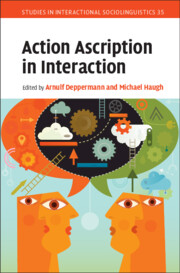Book contents
- Action Ascription in Interaction
- Studies in Interactional Sociolinguistics
- Action Ascription in Interaction
- Copyright page
- Contents
- Figures
- Tables
- Contributors
- Introduction
- Part I Constituents of Action Ascription
- Part II Practices of Action Ascription
- Part III Revisiting Action Ascription
- 12 Action and Accountability in Interaction
- 13 The Multiple Accountabilities of Action
- Book part
- Index
- References
13 - The Multiple Accountabilities of Action
from Part III - Revisiting Action Ascription
Published online by Cambridge University Press: 17 February 2022
- Action Ascription in Interaction
- Studies in Interactional Sociolinguistics
- Action Ascription in Interaction
- Copyright page
- Contents
- Figures
- Tables
- Contributors
- Introduction
- Part I Constituents of Action Ascription
- Part II Practices of Action Ascription
- Part III Revisiting Action Ascription
- 12 Action and Accountability in Interaction
- 13 The Multiple Accountabilities of Action
- Book part
- Index
- References
Summary
In the course of responding to the many themes on action ascription raised in this volume, this chapter briefly outlines some of the main resources – both internal and external to the turn – that may contribute to the process. It is suggested that action ascription involves the integration of ‘bottom-up’ resources within the turn (including grammar, lexicon, prosody, gaze and multi-modality) with ‘top-down’ resources external to the turn (sequence position, location of the sequence within a broader activity, institutional contexts, and personal statuses and the rights accruing to them). Work on the integration of these resources may also shed light on the apparent rapidity with which action ascription is achieved by comparison with the slower pace of turn projection. It is possible that the apprehension of turn-external characteristics may interface with turn initial elements to conduce towards this outcome.
Keywords
- Type
- Chapter
- Information
- Action Ascription in Interaction , pp. 297 - 329Publisher: Cambridge University PressPrint publication year: 2022
References
- 2
- Cited by

